How to (not) race a (half) Ironman #14
Personal insights & advice for the beginner (like me) & the link to the business world.
Raceweek Monday to Thursday
Raceweek Thursday to Saturday
Raceday Sunday (Swim-Transition-Bike-Transition-Run)
Post-race thoughts & general advice
The mental aspect of racing
Rituals
In the past two weeks, many people have asked me what it's like to race an Ironman (or, in my case, a half-Ironman)
They were curious about the practical aspects of the race and the days leading up to the adventure.
How is this now linked to building a business? Executing an Ironman requires mastery of project and change management skills.
In the end, it is exactly that: a project to change yourself. The race itself is just the final deliverable, but the work in the months before - the training, the gear, the nutrition, the time, and the budget - that's what counts. It helps me become the best version of myself. The medal on race day is merely a nice reminder of what I could do on that exact day.
Disclaimer: These are more personal notes, mostly about “me” and what “I” do. It does not mean it works for you, or you should do/try it as well.
Monday to Thursday
Final training (tapering) sessions to maintain form and rest at the same time
a race is as much about my physical as about my mental performance
my physical performance will suck if I am not on top of my game mentally
Consider that in the days leading up to a race
Plan/cancel my social/family events accordingly if possible
Something often overlooked but important to consider: be considerate who I meet the 2 weeks before the race. I don’t want to catch a cold before the race
Get enough sleep (if I can). My sleep is always horrible leading up to a race as I get very excited, but I am used to it already :)
Get my gear ready (write a list(!) and tick off(!) each item(!) once it is packed(!) in my bags)
Continue to visualize race day and the finish line moment
Reflect (and be proud) on my progress, including the harsh winter training and that it all led to this very moment
It is easy to run on a nice summer day, but try it on a rainy, cold Tuesday in January at 6 am
Clean my bike, degrease the chain and re-lubricate. Check the tyres for cracks
Plan my food and hydration strategy, focusing on high-quality sports food with complex carbohydrates
The body runs on carbohydrates during an endurance race
Ideally, not just Haribos or chocolate or cola, but high-quality sports food
Why? The more complex the structure of the carbohydrates, the better the body can absorb them and the longer I can prolong my efforts in desired zones without blowing up
Don’t experiment with any food/drinks/supplies I did not try and train before on race day. My stomach will thank me for it
Thursday to Saturday
Adjust my diet in the days leading up to the race
Try to consume less fibre and protein and more carbohydrates. Examples of suitable foods include pasta, white rice, and white bread. But see what works best for me. Do not start eating something I never eat. Be gentle on my digestive system (I will need it on race day)
I have found success in increasing my intake of isotonic drinks two days before race day to load the system with everything I need during the race
It’s important not to overeat. While carb loading, the practice of consuming vast amounts of pasta every day (especially the evening before) the race, is popular, it's not the best approach - spread it over multiple days
Travel to the race venue at least 1 day in advance. See what is possible given my personal circumstances, but plan a timeline that gives me enough puffer and rest time. It will make a difference
Familiarize me with registration times onsite and check-in times for my bike and other race bags/gear
With bigger events, the registration tents and bike check-in zones/transitions are often in different locations
plan how to get there, parking is often limited and I want to avoid getting stressed
Don't let the presence of other athletes at registration and race locations intimidate me
Many competitors may show off their branded sportswear or finisher shirts from previous events, but it's important to stay focused on my own race preparations
Saturday evening
Sort all necessary items for race day visibly in front of me
Pack my rucksack for race morning as thoroughly as possible
Check the weather and decide what to wear before heading to the start line
Eat dinner around 6 pm and put my phone away early
Having a short and restless sleep the night before the race is normal. Do not get stressed about it
Think about positive things before falling asleep. It is my responsibility to enjoy race day and wake up - despite being nervous - with excitement and a smile
Sunday morning
Get up on time (like really early, approx 4hrs before race start)
Smile!
Have a substantial breakfast and only eat food I have tried before - no experiments
Be mindful of consuming coffee and plan my restroom breaks carefully. The lines for the toilets get long (there will be hundreds of other people wanting to poop in the Dixi toilets before the race starts as they did not time their morning toilet well enough, and it is not a pleasant experience)
Drink 500ml of Isotonic until the race starts (not in one go but as from waking up)
Do not spill the Iso drink on the breakfast table like I did on race morning…
If I need to use the Dixi toilets, carry wet wipes in the back pockets of my tri-suit
Do not stress on race morning. I have trained & prepared for this day
Develop strategies to transform pressure, anxiety, and nervousness into focus, joy, and excitement (scroll down for more)
Eat breakfast at least 2 hours before the race starts
Arriving at the transition zone: Check my bike again after it was out there for a night
Check the tyre pressure
Pro tip: Bring my own pump. Ironman pumps at my race were unreliable and caused stress due to long queues. Save me that stress
Attach my food to the bike with tape, as I can't carry everything in my back pockets, and it's more accessible/visible
Visualise the location of my bike and transition bags one last time (walk the way from the entrance to transition to my bike intentionally). I will arrive pumped up after the swim, and chances are real to get “lost in transition”
Get into my wetsuit on time, but not too early. It's getting hot inside, and I do not want to sweat already before the race starts. Save that energy!


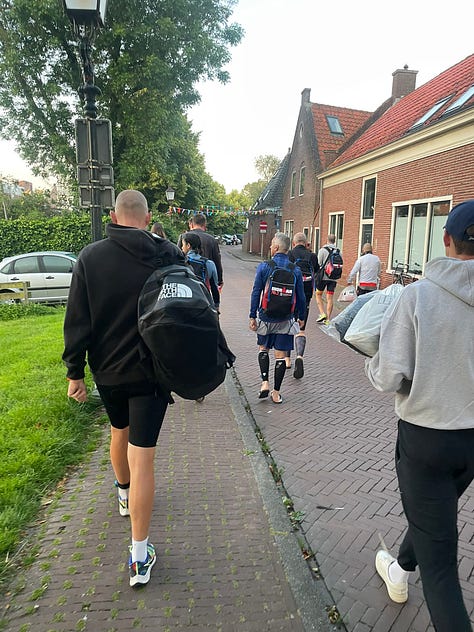

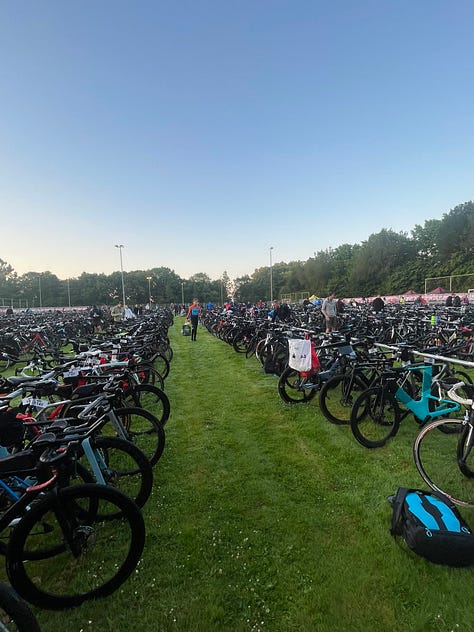
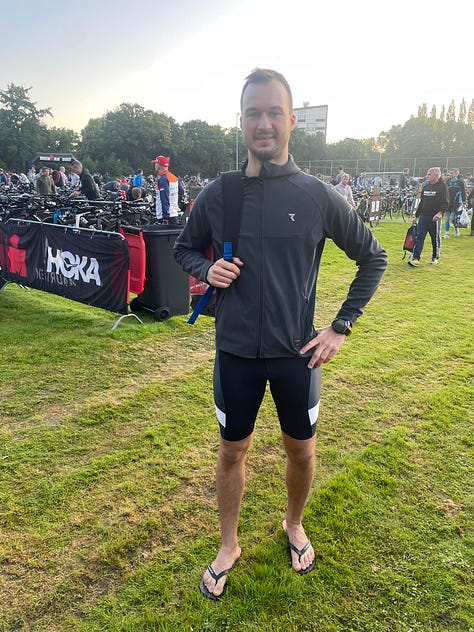
Race morning on the way to the start and transition zone Put on some sunscreen. I will be racing for anything between 4 to 8hrs, and even if the sun is not visible, UV radiation will be present. Skin cancer is real!
Consume a gel 30 minutes before the swim start and according to my nutrition strategy
Remember my nutrition strategy and stick to it. I do not want to bonk in the last 5km of the race—it's not worth it, and I want to recover quickly
If I have supporters along the course, agree with them where they will wait. The track gets busy with thousands of spectators sometimes
Whenever I bring someone along, I tell them to position themselves in spots where normally no one else is. Far away from the start/finish line or aid stations
The race: Swim leg
- If there is a self-seeded start based on swim times, be clear and accurate about my time
- It creates “chaos” when people seed themselves in a faster box and then swim slower, so be considerate and seed yourself properly
- Be considerate of what line I choose. The shortest line has the most traffic. But only 2 metres left or right from it, it is much calmer
Remember: Seed me in the correct box
- Spit into my goggles or use water from the provided water boxes close to the start line to prevent fogging (and no, they are not to clean your feet as some people think)
I have a really hard time with my goggles fogging up. Be sure to have the right ones. Proven and tested. It is super annoying to swim with foggy goggles.
- Familiarize myself with the swim course in advance and decide which side I want to be on and how to approach the first buoy. Inside or outside the pack/action
- Take it easy for the first 150-300 meters, focus on my technique, and find my rhythm. I felt like I forgot everything that I learned the first meters, but I regained control quickly once I focused on breathing
- Don't push myself too hard too early, I will do that later in the swim 🙂
- Enjoy the experience of being in the water, from the energetic atmosphere at the start to the tranquillity of being alone with my breath underwater: bubble bubble breath. bubble bubble breath. bubble bubble breath
- As I approach the end of the swim, get my legs moving and some blood in them. Be prepared to feel dizzy for a moment when I come out of the water as my body adjusts to being on land again. Make use of the many volunteers at the swim exit.
Transition zone 1
- I follow a recovery strategy in transition zone 1
- When I come out of the water with a high heart rate, I avoid sprinting and instead run slowly towards T1. Find my own comfortable pace, this is just the way to transition. The race is long enough to up the pace later
- I take the time to catch my breath and then unzip my wetsuit, pulling it halfway down to my hips
- I remove my goggles and swim cap, being mindful of my steps
- After that, in the transition zone and after finding my transition bag, I work on pulling the wetsuit down firmly
I then take out my bike helmet, put it on my head, and secure it with the cap and sunglasses ( immediate disqualification awaits if your helmet is not closed when leaving the transition area - save yourself that kind of trouble)
Then I put on my bike shoes and stow the wetsuit in the transition bag
- I also place gels and bars into the back pockets of my tri-suit
- Once everything is sorted, I put the transition bag back on the hook and run to my bike, being careful not to trip over others in the busy T1 area
- I remind myself to stay focused, as mistakes can happen. T1 is busy, and people are nervous, including myself
- I grabbed the wrong transition bag and lost 1 minute before realizing my error
- It is less about the time and more about the mental effort to stay focused
- Run to the bike
I unhook my bike from the bar and ensure I don't bump into other bikes
- As I gently (!) run with the bike towards the transition exit, I activate my bike computer
- As I approach the mounting line, get ready to jump on the bike
- If the line is crowded, run 2 or 3 metres further to find some space
- I'm mindful of the tendency for people to crash or fall at the mounting line due to being too rushed and unorganized. Always keep an eye on others
The race: Bike leg
- Take it easy on the bike, take it slow for the first few minutes and don't go for maximum power
- Make sure I have my food, a gel, and a drink ready
- Get into position, lower my head, and push yourself
- Now is the time to assess the damage after the swim. Assess how I am feeling and check my heart rate
- Make any necessary mental adjustments to my bike plan if the heart rate does not match how I feel
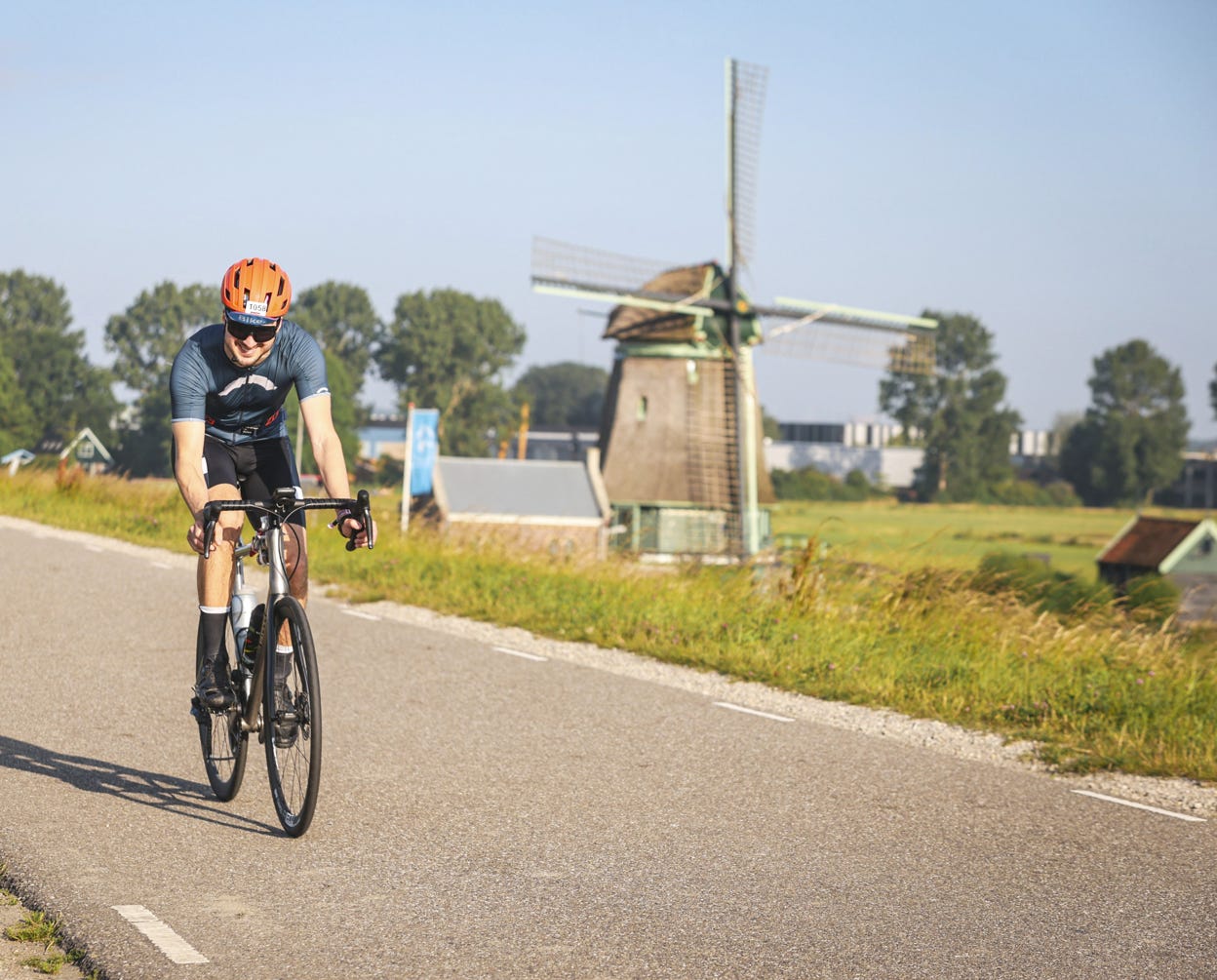
- Remember my nutrition strategy
- In my case, 1 gel every 30mins and at least 500ml of fluid per 30mins, aiming for 100g of carbs on the bike
- Remember that I can't win the race on the bike, but I can lose it if I don't fuel properly
- Many people don't eat and drink enough on the bike and bonk during the run
- If I have my own nutrition, there is no need to stop at the aid station
- In fact, it is better not to, as people are approaching aid stations way too fast and grabbing a bottle from a volunteer at 30km/h is difficult and even dangerous
- Keep a safe distance from other riders to avoid potential collisions or hitting their lost bottles
Stay focused and stick to my plan throughout the ride
- I felt great on the bike
- So great that I wasn’t fully focused anymore
- After taking a sip from my bottle and trying to put it back in the bottle cage, I accidentally launched and lost the bottle
- Losing a bottle can pose a danger, especially if it hits the tyre and leads to a possible crash
It can also derail the nutrition strategy. Like in my case, I needed to recalculate how to get that Iso and the carbs from elsewhere
- I managed to compensate with the gels
- Nonetheless, it was a reminder to stay focused until the end of the race
- Be careful in the corners. I ride a road bike, which allows me to be quite aggressive in the corners
- Riders on a time trial or triathlon bikes are less stable in corners due to the dynamics of their bikes
- It's important to maintain a safe distance when riding and overtaking. Most triathletes (sorry for the generalization) are less skilled in handling their bikes than road and mountain bikers. Their bikes are built for speed and maximum aerodynamics but not for bike handling and technique. You will see what I mean :)
- Approaching transition 2 after 90km, I use the last 1 or 2km to prepare for the transition
- No risks in the last corners
- Finish the rest of my water
- Take another gel
- Approach the dismount line
Transition zone 2
- Approach the dismount line with caution
- Dismount the bike 1 meter before the line and do not attempt to exceed it. Don’t push my luck :)
- Crossing the line or approaching it incorrectly will result in immediate disqualification
- Run with my bike to the designated place and hook it on the bar
- Head to the transition bags area
- Take off shoes, helmet, and cap
- Put on running shoes and a cap
- Place new gels in the back pockets of the tri-suit
- One banana for immediate carb intake after the transition zone
- Pack running gear into transition bag
- Move bib from the back to the front
- Start the running segment
The Race: Run leg
- Same as the bike, ease into the run
- Assess the damage in the first few minutes
- How do the legs feel? How much sun did I get on the bike? How is my stomach?
- Then, check my watch and monitor my heart rate if needed
- Find a person whose pace feels comfortable and run alongside them
- Only after that, check what pace I am maintaining
- Make sure to stick to that pace
- Acknowledge that 21km is a significant distance, especially after completing 1.9km of swimming and 90km of cycling
- Keep in mind that 70% of runners face massive difficulties in the last 5km of the run (don’t be one of them because you are pushing too hard too early)
- Understand that everything could fall apart at the end because 5km is a daunting distance to cover when exhausted
- Instead, aim to stay within the target heart rate zone/overall feeling for the first 15km and then gradually increase the pace
- In my experience, I felt great until 15km and then began to push a little harder
- However, it didn't work out as planned, as I hit a wall at 19km 🙂
- But by then, I knew I would finish the race and just enjoyed the last 2 kilometres
- I remembered the journey to that point
It was fueled by almost one year of dedicated training with no shortcuts or excuses. And normally, I am pretty good at finding either shortcuts or excuses - or both :)
The race: Approaching the finish line
- Many people instinctively sprint the last 100 meters as they near the finish line
- They showcase their strength in the final moments of the race
- This has never really been my style, and I don't recommend it 🙂
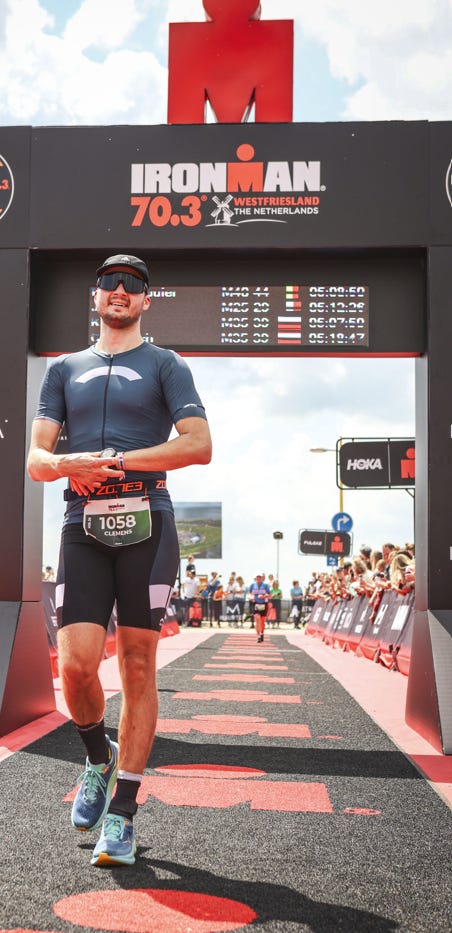
- Instead, gradually reduce my speed, relish each step, lower my heart rate, zip up my tri-suit if it's open, start smiling, and imprint this moment in my memory, as it will vanish swiftly
In general, I'm not a fan of large races. I enjoy the atmosphere, but I struggle with the sheer number of other athletes, especially the reckless ones who think they're professionals when they're not
I often wonder about the character of such individuals in their personal and professional lives. Perhaps the difference is that I participate in these races to incentivize myself for the training efforts the months before. I see it as a personal challenge to race against myself rather than a competition against others
The world keeps moving, and not many people truly care about your accomplishments, so cherish them and become your own biggest supporter.
After the race
- Change into my streetwear
- Take (and enjoy) a cold shower
- Have my flip-flops handy (my toes will thank me)
- Drink a recovery shake to help the damaged muscles repair smoother
Snap some pictures of me and the finish line. It is fun to make a before-after-race comparison

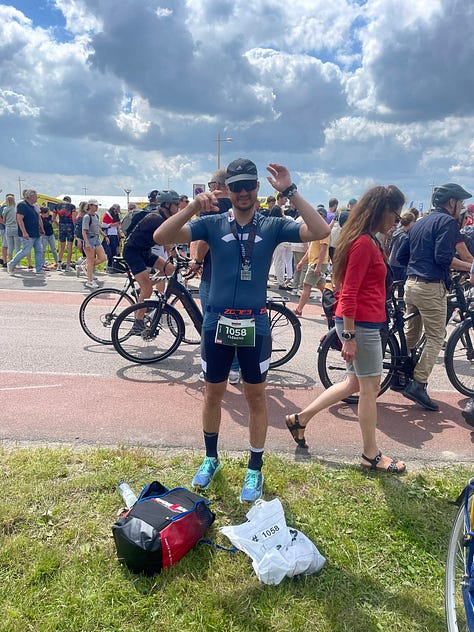
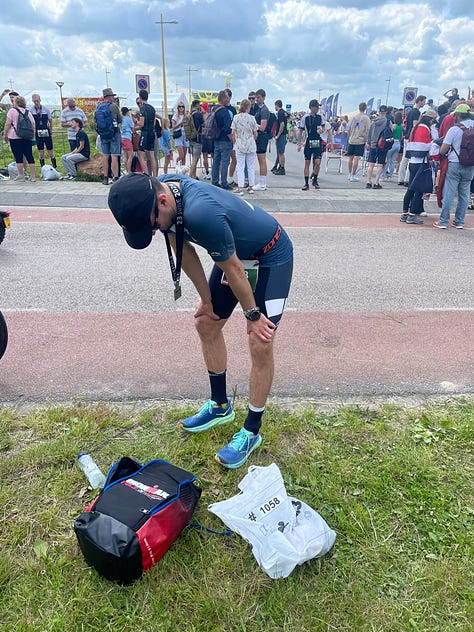



After-race pictures
- Locate the nearest McDonalds and replenish the calories lost
- Leave a voice message for myself about the experiences and listen to it every year from now
Be proud of yourself (in case you are like me, it is a hard one. But at least try)
General advice
- Learn how to change a bicycle tyre (I still suck at it and crossed my fingers nothing will happen during the race)
- Bring my own track pump as the ones on site are bad quality, and there is usually a queue of people waiting for them on race morning
- Wear casual clothes on race morning, and don't change into my wetsuit until 30 minutes before the race
- Create a warm-up ritual
- Prepare strategies to stay focused at the start and not be distracted by others
- Prepare strategies for mentally tough times to counter my thoughts of giving up
- Take wet wipes with me on the morning of the race in case the restroom situation isn't “great”
- Use head protection such as caps at all costs (skin cancer is real)
- Don't forget sunscreen in my race morning bag
- Pack a spare pair of goggles in case mine break on race morning (this really happens, and you don’t want to swim without them)
- if I have supporters, arrange a meeting point after the race
- Make sure I know when to check out of the hotel (ideally, ask for a late check out so I can shower and relax after the race)
- Prepare a streetwear bag for after the race so I can get out of my tri-suit as soon as possible
Mental preparation notes
- Be mentally prepared for a full day of racing and everything that comes with it
- Everything I do in the race requires decisions
I will most likely experience decision fatigue once I cross the finish line (make sure supporters are prepared for this)
- It is OK to be nervous, but don’t forget to enjoy
- It is OK not to sleep well the night before the race. I only slept for 3-4 hours, and research shows that it does not affect your performance
Be one of the few people smiling in the morning on race day. Everyone else is already tense, but it is important to create a positive atmosphere for myself and all the volunteers who give us their time so we can race.
Create my own rituals to help maintain focus on race day. I've always had trouble staying focused on race mornings because I felt overwhelmed by the large number of athletes at the starting line
My mind would often wander, making it seem more like daydreaming than race preparation
But this time, I approached it differently:
I've been working to become a professional and certified coach for the past year. Along the way, I've met amazing people with whom I've practised
I reached out to one of them to coach and help me create rituals for race day and understand why it's important for me to go on those adventures (I had an idea but never tied it together in a nice story)
Rituals
After a couple of coaching sessions, I achieved what I wanted. I got answers and became clear on 2 things:
The ritual I would use on the starting line on race day to maintain focus
The exact reason why I am racing (and enduring) those events
For the tough moments, I wanted a clear story to remind me of and put my mind in its place.
The Ritual
The ritual involved a Zoo where I transformed all the people into animals to help me remain calm and focused and add a touch of humour. But that’s a whole different story but it worked well :)
The Why
Eventually, my mind starts questioning why I'm out there and suggests slowing down and taking it easy or even quitting. I've experienced those moments in past adventures (and wrote about them in my book). After some coaching, I got clear on my “why”:
When I race and go on adventures, I feel like I can truly be myself. I don't need filters, external validation, or the need to be liked or loved. I can be present with my true self, shedding my shields and armor, leaving only my core.
Have you ever wondered why (endurance) athletes often burst into tears after wins or losses? Physical and mental exhaustion leaves us with no energy to appear strong because we are not anymore.
During or after most of my races and adventures, I have cried. Emotions become very raw after the 20+ hour mark, and there's no running from them, no hiding, and no turning back. I genuinely enjoy that vulnerability; it makes me stronger and a better version of myself.
This might sound a bit far-fetched if you're not used to exposing yourself to more intense physical situations outside your comfort zone. But it's really helpful and even essential for me to persist in physically exhausting activities.
Let's team up if you ever want to go on your own adventure race. I am happy to share what I have learned so far.
Next adventures:
The Great Escape, The Bello Gallico and The Legends Trail.
Join me for the first-ever “Night Hiking Adventure” I organize in late August in Brussels. I bring the adventure to your doorstep.
Don’t forget to stay awesome! Thanks for reading!
Clemens




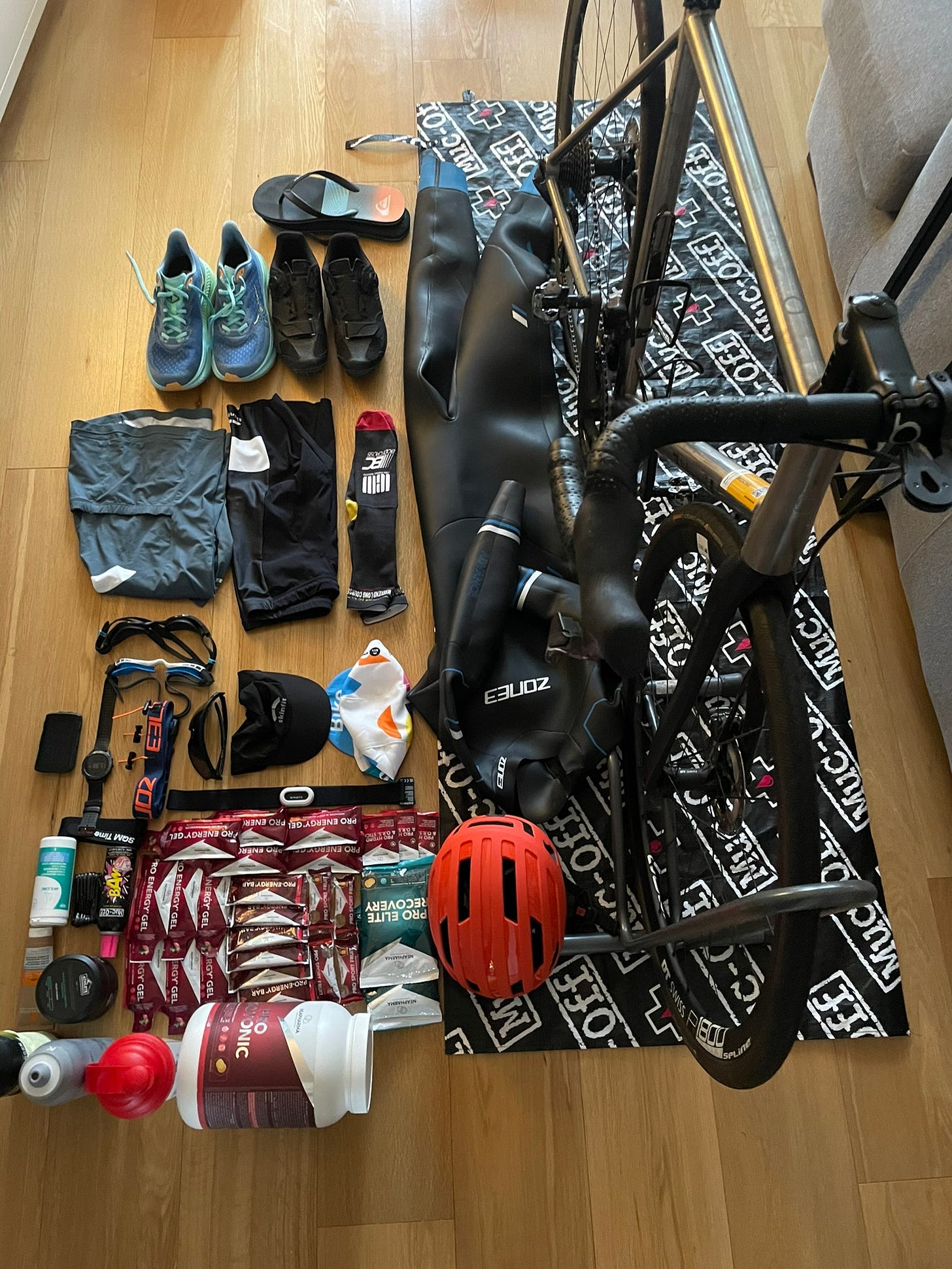






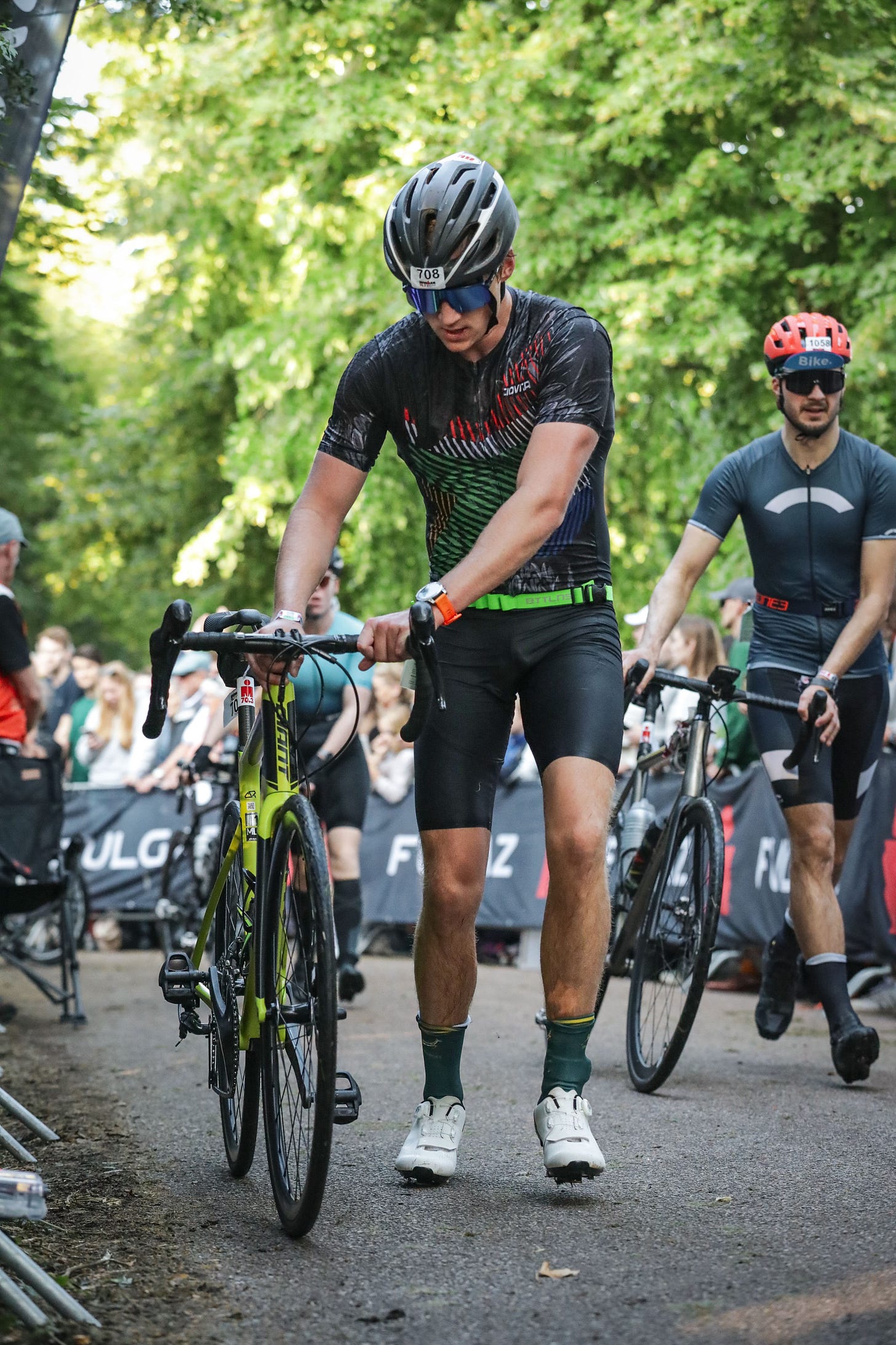

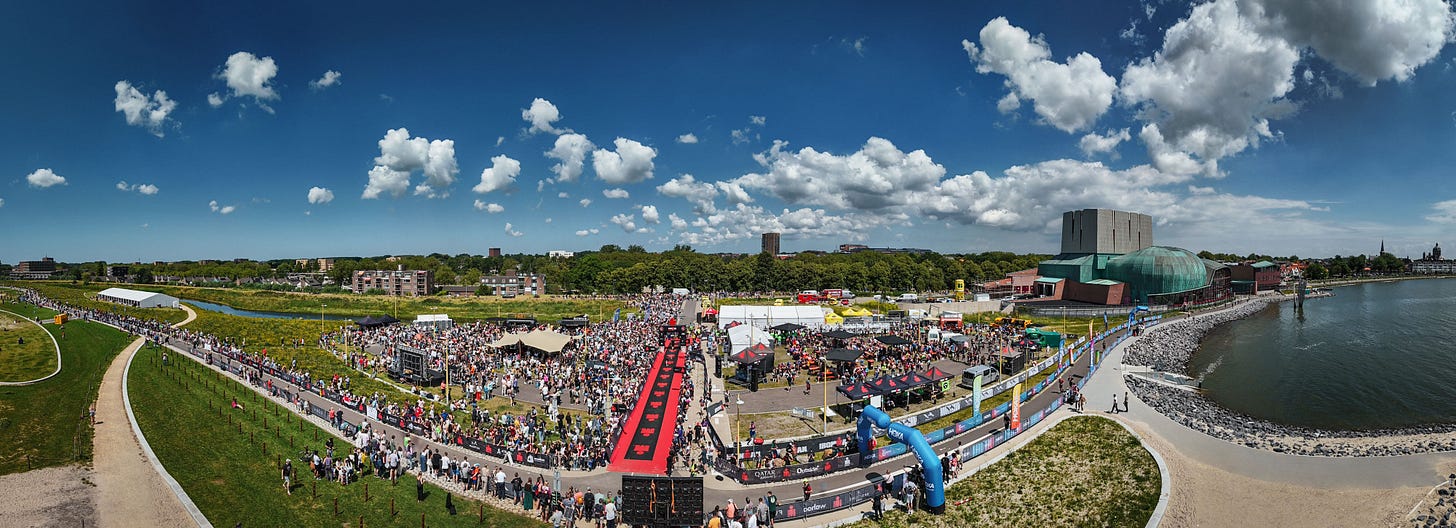

Huge congrats, Clef! I love "assessing the damages" and "lost in transition", great structure. I've done few full Ironmans and still learned a lot from you! Thank you! :)